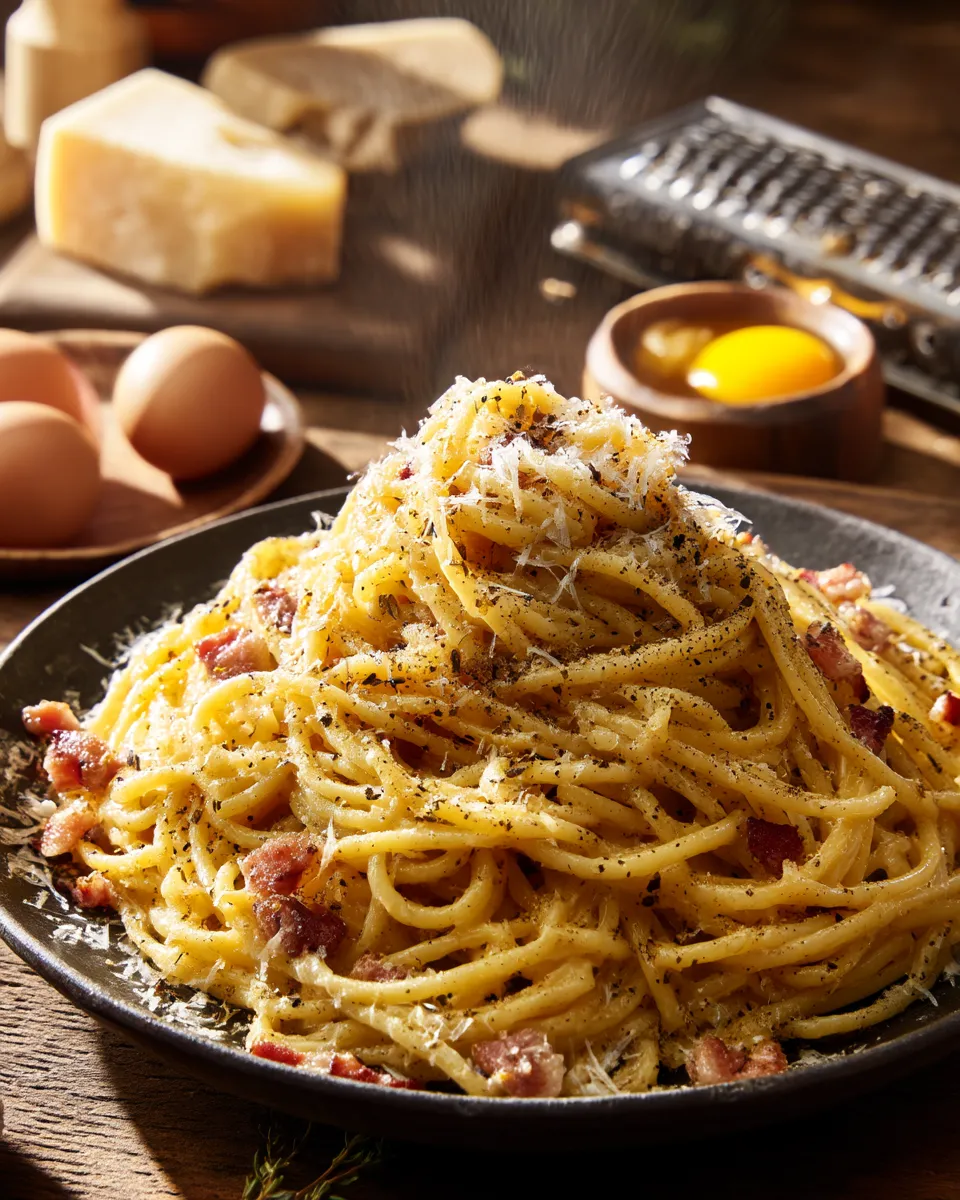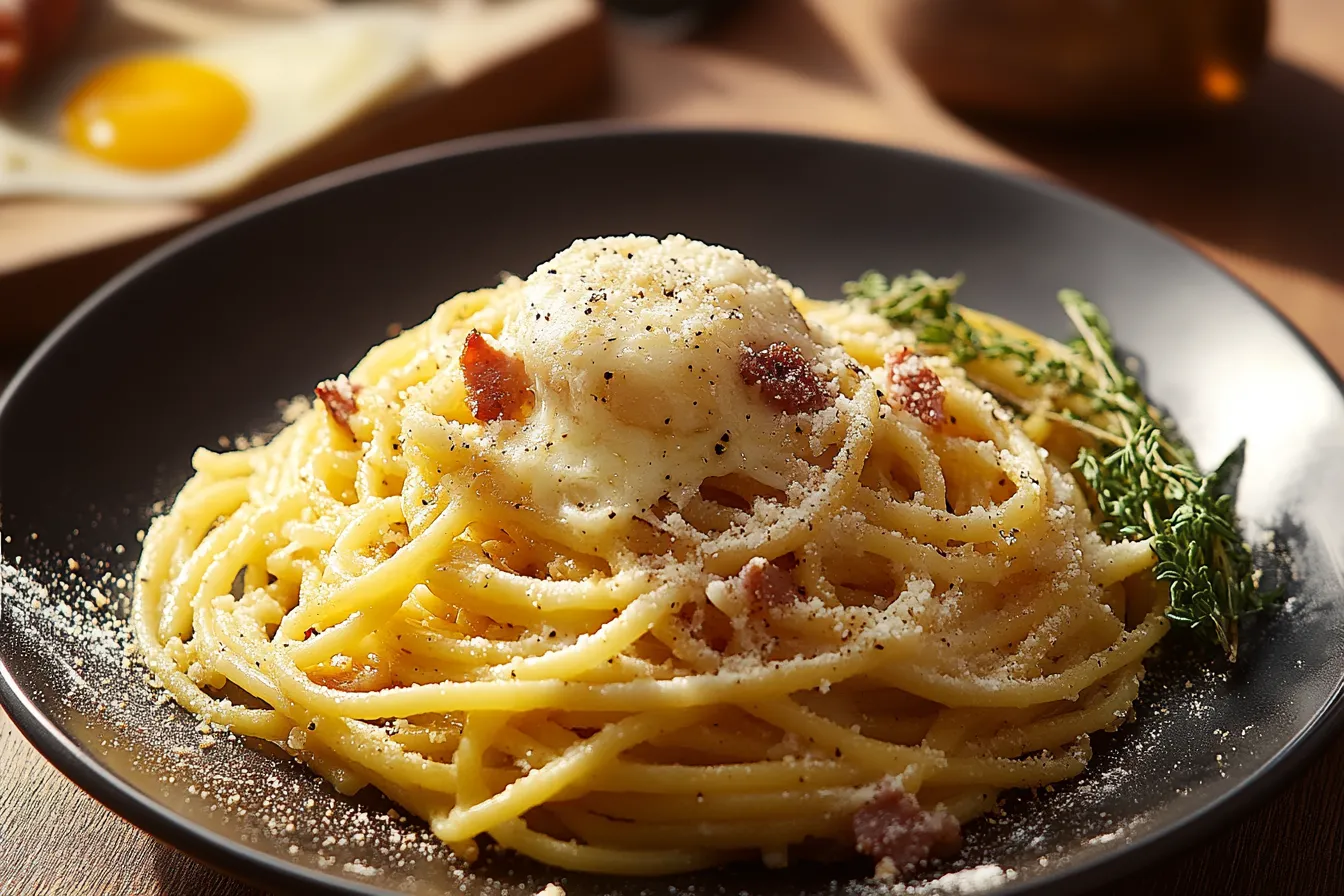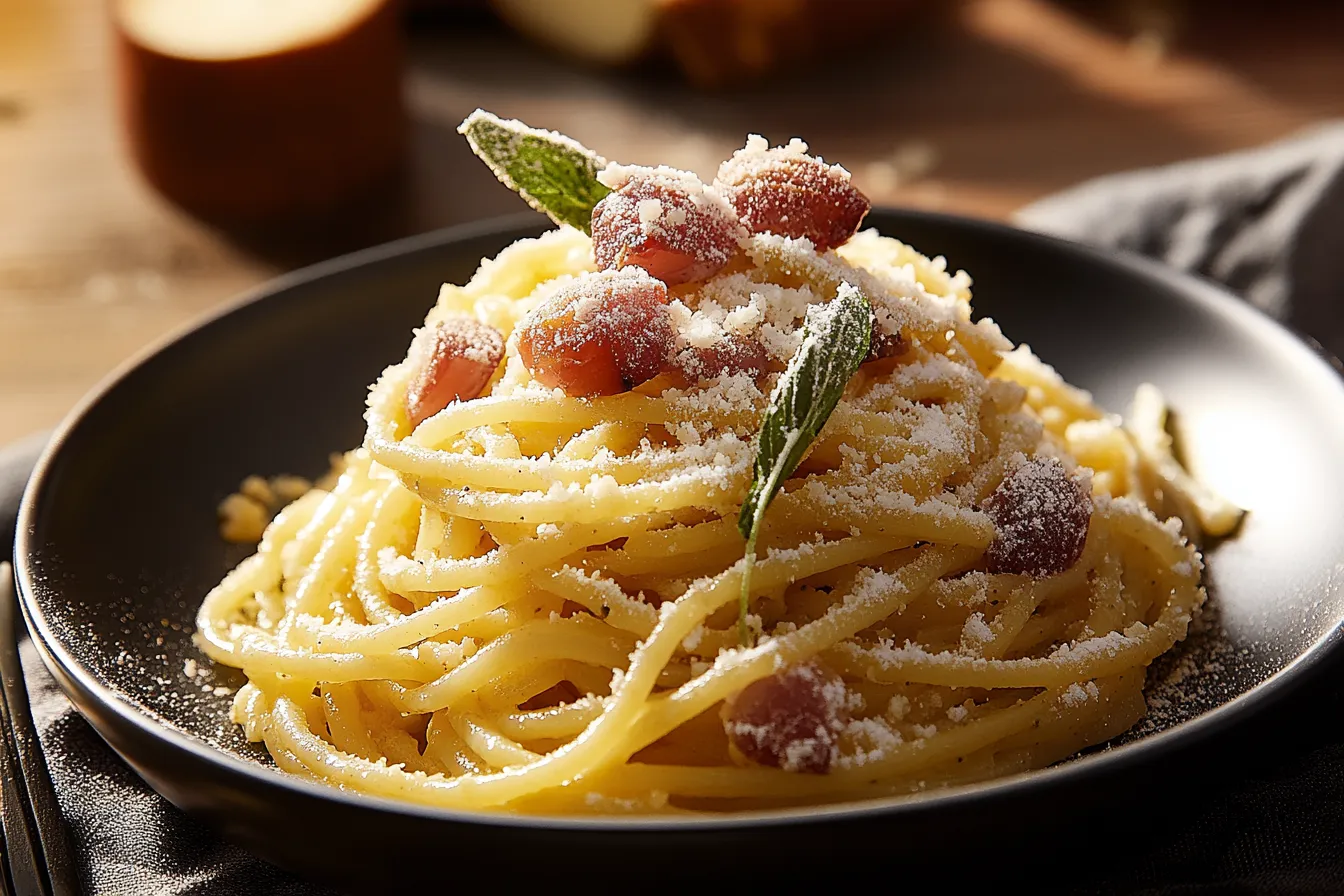 Save
Save
This authentic Spaghetti Carbonara recipe elevates the classic Roman dish with a touch of Swiss finesse through the addition of nutty Gruyère cheese. The result is a silky, luxurious pasta that comes together in just 20 minutes for a restaurant-quality dinner at home—no cream needed.
I first discovered this variation while studying abroad in Switzerland, where I learned that Gruyère adds an incredible depth to carbonara that complements the traditional Pecorino perfectly. My dinner guests always ask for my secret ingredient!
Ingredients
- 400g (14 oz) spaghetti quality dried pasta holds the sauce beautifully
- 150g (5 oz) pancetta diced traditional Italian cured pork belly provides the essential fat and flavor
- 4 large egg yolks creates the silky texture that defines carbonara
- 1 whole egg helps bind the sauce while keeping it fluid
- 1/2 cup finely grated Pecorino Romano adds the traditional sharp saltiness
- 1/4 cup finely grated Gruyère introduces a nutty complexity uncommon in traditional versions
- Freshly cracked black pepper an essential component that gives carbonara its characteristic look and flavor
- Salt for pasta water properly seasoned water is crucial for tasty pasta
- Optional garnish extra cheese parsley very lightly more pepper
Step-by-Step Instructions
- Cook the Pasta
- Bring a large pot of generously salted water to a rolling boil. Add the spaghetti and cook until al dente according to package instructions, typically 8-10 minutes. Before draining, reserve a full cup of the starchy pasta water to help create the silky sauce. The pasta should remain slightly firm as it will continue cooking slightly when combined with the sauce.
- Cook the Pancetta
- In a large skillet over medium heat, cook the diced pancetta until it becomes golden brown and crispy, approximately 5-7 minutes. Stir occasionally to ensure even cooking. Once done, remove the skillet from heat but leave all the rendered fat in the pan as this adds incredible flavor to the final dish. The fat should look translucent and golden.
- Prepare the Sauce Base
- In a medium mixing bowl, thoroughly whisk together the egg yolks, whole egg, finely grated Pecorino Romano, Gruyère, and a generous amount of freshly cracked black pepper. The mixture should be thick but smooth. Carefully add a tablespoon of the hot pasta water to the egg mixture, whisking constantly. This tempers the eggs slightly and helps prevent scrambling when combined with the hot pasta.
- Combine Everything
- Working quickly, add the hot drained spaghetti directly to the skillet with the pancetta and its fat. Take care to keep the skillet off the heat to prevent scrambling the eggs. Toss the pasta thoroughly to coat with the pancetta fat. Immediately pour the egg and cheese mixture over the pasta and stir vigorously. Add small splashes of reserved pasta water as needed to create a glossy sauce that perfectly coats each strand of spaghetti. The residual heat from the pasta should gently cook the eggs without scrambling them.
 Save
Save
The first time I served this to my Italian friend Marco, he was skeptical about the Gruyère addition. After one bite, he declared it might be better than his grandmother's version—though he made me promise never to tell her that! The nutty depth the Gruyère provides creates a memorable complexity that keeps people coming back for more.
How to Serve
The beauty of carbonara lies in its simplicity and immediacy. Serve this dish right away on warmed plates to maintain the perfect silky sauce consistency. Portion the pasta into elegant nests and finish with an additional sprinkle of freshly grated cheese and black pepper. For the ultimate indulgence, consider adding a small spoonful of the rendered pancetta fat over each serving—this is a chef's secret that elevates the dish to extraordinary heights.
Storing Leftovers
While carbonara is unquestionably best enjoyed fresh from the pan, leftovers can be stored in an airtight container in the refrigerator for up to one day. Be aware that the sauce will thicken considerably when cold. To revive leftover carbonara, place in a skillet over low heat with a small splash of water or chicken broth, gently warming while stirring constantly until the sauce loosens and becomes creamy again.
Common Mistakes to Avoid
The most critical moment in making carbonara is combining the egg mixture with the hot pasta. Always remove the pan from heat before adding the egg mixture to prevent scrambling. Another frequent error is not using enough black pepper—carbonara should have a noticeable peppery bite that balances the richness of the eggs and cheese. Finally, never skip reserving pasta water—this starchy liquid is essential for achieving the perfect sauce consistency.
Cultural Heritage
Carbonara has humble origins in mid-20th century Rome, likely created as a hearty meal using ingredients available during wartime—eggs, cured pork, cheese, and pasta. The name may derive from "carbonaro" (charcoal burner), suggesting it was popular among Italian charcoal workers. Adding Gruyère is certainly a modern twist, but this adaptation honors the spirit of carbonara while introducing a subtle complexity that makes this version uniquely memorable.
 Save
Save
Recipe FAQs
- → Why doesn't authentic carbonara use cream?
Traditional carbonara gets its signature creaminess from the emulsion of egg yolks, cheese, and starchy pasta water - no cream required. The silky texture comes from proper technique: tossing hot pasta with egg-cheese mixture off heat, allowing residual warmth to gently thicken the sauce without scrambling the eggs.
- → Is Gruyère cheese traditional in carbonara?
No, Gruyère is not traditional in classic Roman carbonara, which typically uses only Pecorino Romano. This version incorporates Gruyère as a gourmet twist that adds nutty flavor complexity and exceptional meltability while complementing the traditional Pecorino component.
- → How do I prevent the eggs from scrambling?
Remove the skillet from heat before adding pasta and egg mixture. The residual heat from the pasta and pan should be sufficient to create a silky sauce. Stir vigorously when combining, add pasta water as needed to maintain temperature control, and never return the mixture to direct heat.
- → Can I substitute bacon for pancetta?
Yes, thick-cut bacon can substitute for pancetta if necessary, though it will impart a smokier flavor than traditional pancetta. Look for minimally processed bacon with good fat content. For best results, dice it rather than using pre-cut bacon bits.
- → How much pasta water should I reserve?
Reserve about 1 cup of starchy pasta water before draining. You likely won't use all of it, but having extra ensures you can adjust the sauce consistency as needed. Add it incrementally - a tablespoon first to temper the eggs, then small splashes while tossing until you achieve that perfectly silky coating.
- → What's the best way to reheat leftover carbonara?
Gently reheat in a skillet over low heat with a splash of water or broth to revive the sauce. Stir constantly to prevent sticking and splitting. Alternatively, microwave at 50% power in short intervals, stirring between each. Be aware that reheated carbonara will never quite match the silky perfection of freshly made.
